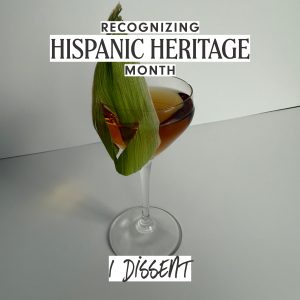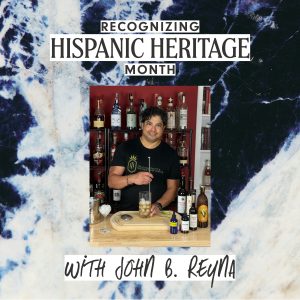Stirred & Bitter: SCOTUS Celebrates National Hispanic Heritage Month
By John B. Reyna
John B. Reyna is the Managing Attorney at the Texas Hospitality and Non-profit Law Center and the Georgia Hospitality and Non-profit Law Center. The views and opinions expressed in this article are the author’s and do not necessarily reflect the views or positions of any entities the law firms represent or those of the Tales of the Cocktail Foundation.
On September 8, 2025, the Supreme Court of the United States declared that the Fourth Amendment no longer protects Latinos’ constitutional right to be free from arbitrary interference by law enforcement and that Latino U.S. citizens are now second-class citizens. The Court’s order paves the way for racial profiling, harassment, wrongful detention, and violence against Latinos.
In the wake of the Supreme Court’s ruling, the hospitality industry’s silence has been deafening. Does the industry not recognize the importance of the Latino community to the hospitality industry and the economy? Does the industry not acknowledge Latinos, regardless of citizenship, as people worthy of the liberties and protections that the Constitution guarantees? Or is the silence due to a lack of understanding about what the Supreme Court ordered?
As a Latino attorney with decades of experience in the hospitality industry, I am here to break the silence. What follows is an examination of the Perdomo v. Noem case from the District Court level up to the Supreme Court. Everyone should understand how our judicial system failed 19% of the American population.
For those who question whether a Tales of the Cocktail Foundation editorial is an appropriate venue for this discussion, here are some stats to digest. In 2024, Latinos made up: 30.7% of all food preparation and serving related occupations; 21.5% of all bartenders; 27.5% of all waiters and waitresses; 41% of all cooks; 42.5% of all dishwashers; 71.1% of all graders and sorters of agricultural products; 46.2% of all miscellaneous agricultural workers; and 30.1% of all butchers and other meat, poultry, and fish processing workers. Further, the total economic output, or gross domestic product (“GDP”), of Latinos in the U.S. was $3.2 trillion in 2021. To put that into perspective, if Latinos living in the United States were an independent country, the U.S. Latino GDP would be the fifth-largest GDP in the world. The U.S. Latino GDP has been the third-fastest-growing GDP among the world’s largest economies since 2010. Thus, when our Government attacks Latinos, the hospitality industry will feel the pain via loss of labor force and consumers. Consequently, Perdomo v. Noem will have a ripple effect throughout the hospitality industry.
So, how did we get here, what’s at stake, and what can the hospitality industry do to support the Latino community?
Operation At Large
On June 6, 2025, the Trump Administration launched “Operation At Large” in Los Angeles. Teams of armed and masked agents jumped out of vehicles, tackled and handcuffed Latinos before asking questions, identifying themselves as immigrant officers, or showing warrants.
On June 20, 2025, five individuals stopped during Operation At Large and four associations collectively filed a putative class action in Federal District Court against the Federal Government (Perdomo v. Noem). The plaintiffs allege, among other things, that the Government violated the Fourth Amendment by stopping individuals without reasonable suspicion based on nothing but racial and language profiling. The plaintiffs then moved for a temporary restraining order (“TRO”) to prevent the Government from conducting further stops based solely on four factors: (1) race and ethnicity; (2) speaking Spanish or speaking English with an accent; (3) presence in a particular location; and (4) occupation.
The Fourth Amendment imposes limits on search-and-seizure powers to prevent officers from arbitrarily and oppressively interfering with individuals’ privacy and personal security. Immigration officers may stop an individual for questioning if they have a reasonable suspicion, based on specific, articulable facts, that the person being questioned is in the country illegally.
The District Court granted the TRO prohibiting the Government from relying solely on the four factors, either alone or in combination, to form a reasonable suspicion for a detentive stop. The keyword here is solely. The District Court found “ample evidence” that the Government relied solely on one or a combination of those four factors—often without fundamental questioning and with violence—and ruled the seizures unconstitutional. The Government did not present evidence that it based its seizures on anything other than those four factors. The four factors are “no more indicative of illegal presence in the county than of legal presence,” wrote the District Court.
The Ninth Circuit Court of Appeals
The Government appealed to the Ninth Circuit and moved for a stay of the TRO. By requesting a stay, the Government was asking the Ninth Circuit to “pause” the District Court’s TRO while it is being appealed. If the Ninth Circuit grants the stay, the Government can keep doing what it is being sued over—federal immigration officers stopping Latinos based solely on the four factors—while the appeal is pending.
The Ninth Circuit denied the Government’s request, and then the Government filed an emergency application with the Supreme Court.
The Supreme Court’s Shadow Docket
When you envision a case before the Supreme Court, you are envisioning a case on the merits docket. There, the parties write briefs presenting their legal positions, oral arguments are conducted where the Justices can ask questions, and then the Justices meet privately in person to discuss the case and vote on it. They spend months writing lengthy majority opinions explaining who won and lost and why, or, in the case of a dissenting opinion, demonstrating why the majority’s opinion is incorrect. A case on the merits docket takes a year or longer to get through, not including the months or years it took to pass through the lower courts in the first place. The Court must take the time to do so, as its decision will become precedent, and a comprehensive explanation helps lower courts apply the decision to subsequent cases involving similar facts or legal issues.
The shadow docket is a far cry from the merits docket. Often, when someone sues the Government, a district court orders the Government to stop doing what they are being sued over (e.g., a temporary restraining order). The Government can appeal that order all the way to the Supreme Court through an application to the emergency docket (aka the shadow docket). Here, unlike a merits case, the Court must respond quickly, often only after a few days or weeks. There are no written briefs or oral arguments. The Justices don’t meet in person to discuss the case. The Justices vote by email, and the Court generally does not disclose how the Justices voted. The rulings typically don’t explain why the Court ruled the way it did. Instead, the ruling is a few sentences stating whether the application is granted or denied, and they are often unsigned. At the shadow docket stage, no one wins the case because the decision is not based on the merits of the case. That determination remains with the lower courts (e.g., a district court). However, these vague shadow court rulings offer little to no guidance to lower courts and parties regarding the basis for the Supreme Court’s ruling. After the shadow docket ruling, the case can proceed from the District Court to the Circuit Court and then onto the merits docket of the Supreme Court.
SCOTUS Lurking in the Shadows, ICE Racially Profiling in Broad Daylight
The sole issue before the Supreme Court was whether it should stay (i.e., pause) the District Court’s TRO while the case proceeds in the lower courts. If the Supreme Court grants the stay, federal immigration officers could resume stopping Latinos based solely on the four factors.
On September 8, 2025, the Supreme Court granted the stay via an unsigned order through its shadow docket. The order did not provide an analysis of why the Court granted the stay. Yet, the unexplained order’s impact will affect how millions of Latinos live their daily lives, knowing they are legally subject to racial profiling.
Justice Brett Kavanaugh wrote a concurring opinion that agreed with the outcome of the Court’s decision but disagreed with the reasoning or rationale behind it. No other Justice joined his concurrence, which reveals division among the majority. His concurrence is a non-binding interpretation of the law, so future cases are not obligated to follow his opinion.
The Government had the burden of demonstrating a likelihood of success on the merits of the Fourth Amendment issue. At least five justices determined that the Government had shown just that. That is a powerful signal that the majority thinks Latinos do not deserve Fourth Amendment protection.
Justice Sonia Sotomayor’s blistering dissent, which Justices Elena Kagan and Ketanji Brown Jackson joined, exposed the dangers facing Latinos in this country. “The Government, and now the concurrence, has all but declared that all Latinos, U.S. citizens or not, who work low wage jobs are fair game to be seized at any time . . . and held until they provide proof of their legal status to the agents’ satisfaction,” Justice Sotomayor wrote. Operation At Large’s seizures were based solely on four factors that depict an enormous category of presumably innocent people. The Fourth Amendment prohibits this. Or at least it used to.
The Government also had to show that it would be irreparably harmed if the TRO remained in place. The Government argued that the TRO would “deter officers from stopping suspects even when they have reasonable suspicion on other grounds.” The majority agreed and, in doing so, misinterpreted the TRO.
Nothing in the TRO prevents the Government from enforcing its immigration laws, if it does so in a manner that stops individuals based on additional facts beyond the four factors. Clearly, the majority ignored the keyword solely in the TRO.
Justice Sotomayor also acknowledged that “The Constitution does not permit the creation of such a second-class citizenship status.” Yet, Latino U.S. citizens must now carry sufficient documentation to prove their legal status to the satisfaction of an agent. But when state-issued IDs are not enough to prove that they deserve to walk freely, does that mean Latino U.S. Citizens have to carry passports?
The Court’s unexplained order has endowed the Government with the authority to rely solely on the four enumerated factors that the lower courts found to be unconstitutional. That is a green light to racially profile Latinos and to grab and kidnap. To date, thousands of people have been seized simply because of their looks, how they speak, and their occupation. The Court’s stay forces many more to the same attacks.
And this is not hyperbole. On September 16, 2025, the U.S. Customs and Border Protection began Operation At Large in Chicago. Gregory Bovino, who led Operation At Large in LA, is leading the Chicago efforts. The Chicago version already resembles the LA campaign. And why wouldn’t it? The Supreme Court gave the Trump administration permission to seize people who look Latino and work a low-wage job.
Justice Kavanaugh’s tone-deaf concurrence claims that the Government “sometimes makes brief investigative stops” at places where undocumented people are likely to work. He insists that if ICE officers learn that they stopped a U.S. citizen or someone otherwise lawfully in the United States, the questioning is brief, and they promptly let the individual go.
The concurrence’s obliviousness to the District Court’s record is unconscionable. Immigration agents are not conducting brief stops for questioning. The Government is seizing people using firearms, physical violence, and warehouse detentions. Two of the plaintiffs attempted to explain that they are U.S. citizens; agents pushed one against a fence with his arms twisted behind his back, and the other was taken away from his job to a warehouse for further questioning. Also, Justice Kavanaugh ignored the District Court’s record regarding the conditions of specific detention centers and the detainees’ access to legal counsel.
During Operation at Large, ICE used the basement of a federal building in Los Angeles to hold detainees. It lacked beds, showers, and medical facilities. Detainees were routinely deprived of sufficient food and water and necessary medical care and medications, even when informed about their medical conditions. A few hours in those facilities would be hell, let alone days or weeks.
Further, unlike criminal courts, where the law mandates that no one face trial and punishment without an attorney to protect their rights, people facing detention and deportation do not have the right to a public defender. But even when detainees had access to counsel, the Government often restricted their access.
How can the Hospitality Industry Support the Latino Community?
Considering all the above, this National Hispanic Heritage Month, the Latino community needs the support of the hospitality industry. Here are some things that brands, bars, and restaurants can do:
- Advocate for lawmakers at every level of government—state and federal—to enact laws and policies that prohibit racial profiling and defend the Fourth Amendment.
- Provide education regarding the Fourth Amendment and other constitutional rights.
- Hold trainings for staff on what to do if ICE arrives in the workplace and provide materials in both English and Spanish.
- Partner with local legal aid organizations to offer “Know Your Rights” workshops.
- Donate to non-profit immigration attorneys.
- Maintain a list of trusted immigration attorneys and hotline numbers; display these visibly in staff spaces (e.g., BOH and break rooms).
- Endorse government-funded attorney programs for detention and deportation actions (i.e., public defenders).
- Support a streamlined process for obtaining work permits.
- Advocate for a more straightforward path to citizenship.
- Encourage buddy systems: walking to cars after shifts or checking in after making it home safely.
- Share information and resources with everyone far and wide. Use your platform.
- Collaborate with other businesses to form networks to coordinate support.
- Provide de-escalation training.
Most importantly, check in with your Latino friends, colleagues, and employees. How have their lives changed recently? How are their families? Have they been threatened with calls to ICE? Are they afraid to speak publicly because of their accent? Are they scared to take public transportation? How can I support you?
Here are links to some immigration resources:
ACLU Know Your Rights: Find information about Constitutional rights and how to express them during encounters with police or immigration officers.
American Business Immigration Coalition: A 501(c)(3) organization promoting bipartisan immigrant solutions that secure both the border and workforce.
National Immigrant Law Center: A 501(c)(3) organization dedicated to defending and advancing the rights and opportunities of low-income immigrant communities.
Immigrant Legal Resource Center: A 501(c)(3) organization providing legal training and educational materials and engaging in advocacy to advance immigrant rights.
Last Call
Ultimately, the Supreme Court and the Trump administration have made Latinos’ very existence political. The Court’s decision does not surprise me, but that expectation doesn’t diminish my pain or anger. Make no mistake, if the Government can legally stop individuals based on what they look like and how they speak, then no one is safe from arbitrary detention.

 I Dissent
I Dissent
0.75 ounce Nixta Licor de Elote
0.75 ounce Sol Tarasco Charanda Single Argricole Añejo Rum con Hongos
1.5 ounces Medium Sherry (recommend Hartley & Gibbs blend of Amontillado)
1/8 teaspoon Pedro Ximenez Sherry vinegar (recommend Arvum vinagre de Jerez Riserva al Pedro Ximenez)
4 drops Bittermens Xocolatl Mole bitters
2 drops 20% saline*
Stir all the ingredients over ice, then strain into a chilled Nick & Nora glass. Garnish with corn husk.
*saline recipe
80 grams filtered water
20 grams kosher salt
Combine the water and salt in a glass bowl and whisk until the salt has dissolved. Transfer to a glass dropper bottle and refrigerate until ready to use.


About John B. Reyna
John B. Reyna bridges the worlds of hospitality and law. He serves as outside general counsel to bars, restaurants, chefs, bartenders, and entrepreneurs, as well as to public charities supporting the hospitality industry. His mission is simple: to help the people who nourish their communities thrive—legally, creatively, and financially.
Before becoming a lawyer, John spent more than 15 years in the food and beverage industry, working his way through the ranks from dishwasher to Sommelier, Restaurant Manager, and Banquet Manager. That experience shaped not only his understanding of how the industry works but also his deep respect for the people who make it run. He also holds a WSET Level 3 Award in Wines.
John and his wife, Shen, own Teakwood Tavern Hospitality, a hospitality consulting company focused on beverage strategy, wine and spirits education, and event services.
An educator at heart, John has taught Restaurant Management and Beverage Management at the University of North Texas at Dallas School of Business, as well as Negotiations at the College of Law.
In addition to his legal work, John remains active in the nonprofit space. He has served on boards for several hospitality-focused nonprofit organizations. Currently, he is a member of the Board of Directors for Good Work Austin and the Policy Committee for the Tales of the Cocktail Foundation.
John and Shen now call Savannah, Georgia, home, where they live with their dogs, Rhône and Tokaj, and their cat, Jura.






